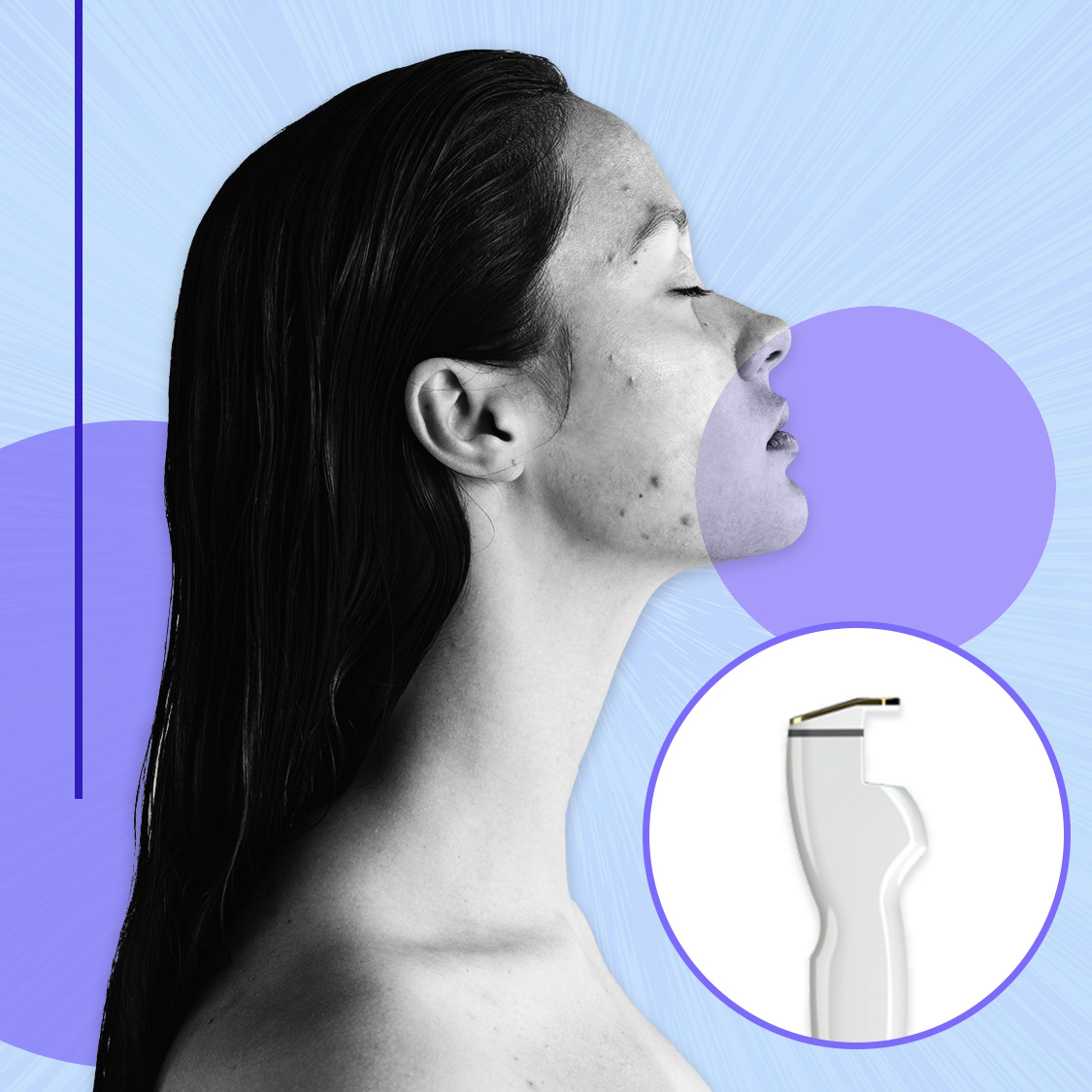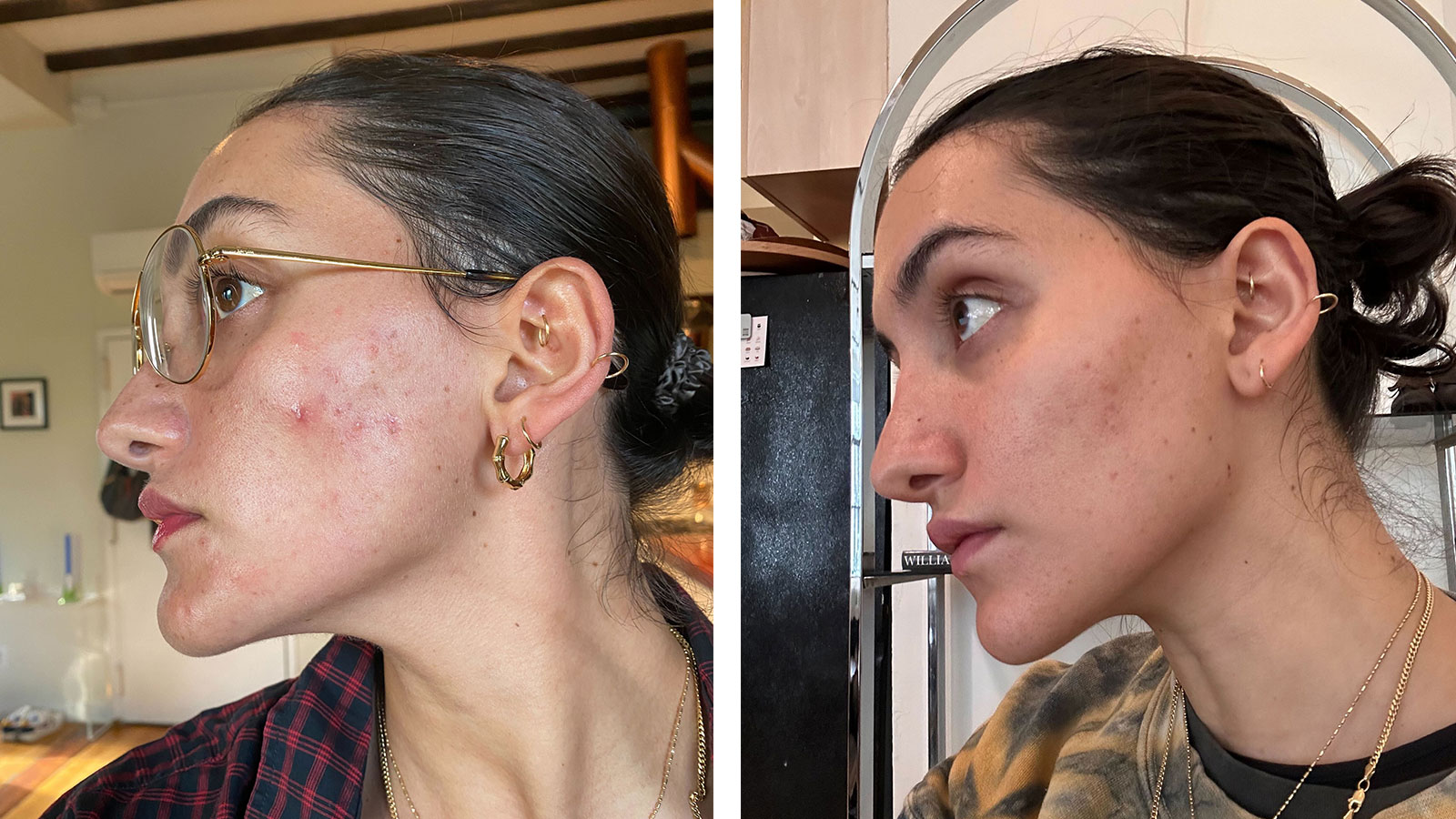
The one constant in my journey to clear skin has been the inconsistency of my progress. Rarely do my worst skin days correspond with any traceable changes—in products or habits or seasons, to name a few—and the same is true of the times when my skin is at its clearest. Facialists said it could be hormonal imbalances (it wasn’t), friends said it was just inflammation (technically true; also unhelpful), the internet told me it was everything (the same as telling me it was nothing). The most helpful advice was from my childhood dermatologist, who said I have acne-prone skin, and, as such, will have acne.
This advice spared me from some nonsense: falling for questionable BeautyTok hacks, splurging on exorbitant serums, hyper-fixating on every breakout. But I’d been playing pimple Whac-A-Mole for almost half my life, and was beginning to feel like the lone adult in an arcade full of kids. When acne is largely regarded as an adolescent problem, it makes sense that it's clinically treated that way, too. I yearned for a one-time fix-all; to be held by the hand and escorted out of the arcade for good.
While a common alternative to prescription medication is a routine set of facials, I've rarely been tempted by the treatment du jour, nor have I experienced long-term results from the few I’ve tried. But earlier this year, I was given the opportunity to undergo a new laser treatment called AviClear. When I texted my cousin, a nurse practitioner who works in dermatology (and my unofficial skin consultant), she called AviClear “all the rage in the acne/laser community.” Sensing my skepticism, she advised me to give it a chance.
The new-to-the-scene laser treatment secured FDA approval last year, becoming the first of its kind to selectively target sebaceous (oil) glands and treat acne at its source. Using a 1726-nanometer wavelength laser, it suppresses the glands without damaging other parts of the skin. In the past, this sort of oil gland suppression came in the form of an oral medication, the most popular being Accutane—a pill notorious for a long list of side effects that need to be carefully monitored. This includes “dry skin, dry eyes, nosebleeds, joint pain, and an increased risk of depression and suicide,” says Dr. Michelle Henry, a board-certified dermatologist and CEO of Skin & Aesthetic Surgery in Manhattan, one of New York's AviClear providers.
As such, AviClear is dubbed the “laser alternative to Accutane”—a hefty promise considering the prescription it’s seeking to replace. “Unlike Accutane, AviClear has no known serious side effects,” Dr. Henry says. “It does not require any blood work or laboratory tests and consists of just three 30-minute treatments, 30 days apart, making it a time-saving treatment option.”
Another draw of AviClear is that it can be used to treat mild, moderate, or severe acne, including persistent hormonal breakouts. It’s effective in treating acne on the back, chest, and face, and is suitable for all skin types and tones. Described as a “generational” solution, it can be used to treat both adolescents and adults.
When acne is largely regarded as an adolescent problem, it makes sense that it's clinically treated that way, too.
It’s a persuasive answer for people who regularly ask themselves, Is my acne really bad enough to justify all this? And so, I decided to give it a go.
When I arrived at Dr. Henry's office for my first session—I was getting the recommended three treatments—she briefed me on what to expect, explaining that she would prep my face, laser it, and send me on my way. There would be some stinging, a little redness, and zero downtime. My face was wiped with acetone to remove my natural oils, then sprayed with water (in this case, La Roche Posay's Thermal Spring Water) to make the laser work properly. Dr. Henry started the treatment on my forehead, pressing the device's icy cold nozzle firmly onto my skin. The machine, which was connected to the nozzle via a tube, made a text tone-like sound when it was ready to go. Then, the laser emitted its first zap.
After each zap, the nozzle was moved to a new location, and the process was repeated across my entire face and upper neck. Every now and then, the machine would make an error sound, and Dr. Henry would reposition the nozzle slightly. She later explained that the device must be applied with even pressure in order for the laser to work, which is why some areas take multiple tries—and why sessions can vary in length based on each patient’s bone structure.
The laser itself is not painless, and the zaps felt a bit like static shock or the snapping of a rubber band. Still, the pain was bearable; in some areas, I didn’t feel anything at all. I found myself flinching every now and then, but only because some parts of my face—temples, cheeks, nose—were more sensitive than others. Again, this is to be expected. Patients may feel more pain in spots where they have more nerve endings or a higher concentration of oil glands. But much like with a deep tissue massage, I actually wanted to feel each zap—to have some visceral indication that this treatment, which was operating at a microscopic level, was actually doing something.
After roughly 20 minutes, my first session was complete, though you wouldn’t know it if you looked at me. I had a little redness (“it typically goes away within a few hours,” Dr. Henry told me), and by the time I made it back to my office, my skin had returned to normal. The only product that was applied to my face after the session was sunscreen, and I was told that I could put on makeup later that evening. Patients are also advised to avoid products with active ingredients (think: retinoids, vitamin C serums, topical acne creams) for three to five days post-treatment. Otherwise, “You can immediately resume normal activities after the treatment,” Dr. Henry said.
In the days following my first treatment, my skin was noticeably less oily, and also less reactive to my usual breakout triggers, like wearing makeup all day. My blemishes didn’t magically vanish, but the speed at which my face became coated in its usual oil slick was reduced. The blotting papers were moved to a lower-priority pocket of my purse; my skin’s condition moved to a lower-priority pocket of my brain.
After my second treatment, I felt less oily, but was still experiencing breakouts. “Some patients will experience purging within the first seven days [after a session],” Dr. Henry reassured me. “We increase the energy each treatment, which may cause inflammation.” That said, my breakouts were mostly concentrated around my cheeks, which is an area that often flares up due to sweat and makeup—not oil. By comparison, I noticed less oil-induced blackheads around my T-zone, and my pores appeared to be smaller as a result.
It’s also worth noting that AviClear’s clinical studies are based on data from patients who received all three treatments, though you can opt to receive just one or two (patients may go this route if their skin concerns are more mild, or if they're looking to make treatment more affordable, for instance). I decided to receive all three sessions as this is recommended by dermatologists to ensure complete coverage of the treatment area. “Getting the full treatment provides the clearest picture of the results you can anticipate,” Dr. Henry says. This is important when you consider the price: AviClear can cost anywhere from $3,000 to $4,000 for all three treatments, though it varies based on factors like geography and provider. And despite being marketed as an alternative to Accutane, AviClear is unlikely to ever be covered by insurance. “No laser treatments are [covered], and insurance companies are covering less and less acne medication in general,” Dr. Henry says.
When I arrived for treatment number three, I was less oily than usual, and, unlike before, was also experiencing fewer breakouts. The deep, cystic pimples that regularly formed on my cheeks were appearing less frequently. When they did, they were smaller and less inflamed.
Once again, I was wiped down, watered, and zapped, bringing my AviClear experience to a close—sort of.

It wasn’t until a few months after my last session that I became consciously aware of my improvement. The grease that normally formed in my T-zone was reduced to a dewy glow, and my skin was punishing me less for late nights of dancing in a full face of makeup. As the weather warmed up, I braced for my skin’s least favorite season, when the soupy, steamy New York City air becomes a breeding ground for skin-clogging sludge. And still, I’ve noticed less oiliness and irritation, fewer clogged pores, and less breakouts of all sizes. According to the clinical trials, 90 percent of AviClear patients saw improvement in their acne after six months, which is where I am right now. New 12-month data shows that this number increases over time.
None of this is to say there aren’t perks to fast-acting facials, and in some cases, the need for repeated, lower-tech treatment is the core of a treatment’s allure: a reason to regularly pamper ourselves and find pause in the pursuit of self-care. I too have been charmed by the Instant Gratification Model—no regrets!—but AviClear does not fall into this category. While dermatologists may struggle to alleviate sticker shock when treatment results are not immediate, this gradual progress may be a relief to those who seek out AviClear in the first place.
So—what does life after AviClear look like?
“You may no longer need spironolactone, topical prescription tretinoin, or other prescriptions used to help lessen breakouts,” Dr. Henry says. “For over-the-counter products, you may not need ultra-drying skincare products, as your sebaceous glands will produce less oil after AviClear.” While I'm not 100 percent acne-free, I’m excited to watch the slow-but-steady progress play out.
When I didn’t see immediate results after my last session, I was reminded of those facials du jour; the fleeting delights and the subsequent letdowns. I’ve started to inspect my skin with more optimism in the months since—cataloging improvements, and practicing patience on days where there is none. “The thing that is so great about AviClear is that your skin just continues to get better month after month,” Dr. Henry says. “I always tell patients I can’t wait to see their skin a year after their final treatment.”







